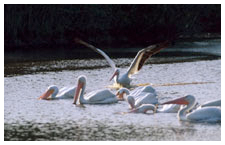
Migrating American white pelicans spotted around the Choctawhatchee Bay
With a wingspan as great as nine and a half feet, the American white pelican is one of North America’s largest birds. Unlike the brown pelican, which is found year-round in Florida, and non-breeding white pelican juveniles, healthy adult white pelicans are winter visitors to the state. In the summer, white pelican adults breed in colonies on lakes in the interior of western Canada and the northwestern United States. Winters are spent in southern Mexico, southern California and along the Gulf Coast states of Texas, Louisiana, Mississippi and Florida.
White pelicans feed differently than brown pelicans. They do not plunge dive as brown pelicans do, instead white pelicans float on the surface, submerge their heads and scoop up fish. They also often fish cooperatively in small groups, herding the fish in front of them.
In flight, white pelicans have a graceful strong flight and usually fly in large flocks high in the air and in a V formation. Adults are a distinctive white with black wing tips. The bill, legs and toes are reddish-orange or pink.
While brown pelicans within peninsular Florida usually nest in mangroves or other trees , white pelicans build nests right on the ground. They clear or scrape an area and rim it with dirt, sticks or other debris.
During the height of the plume trade in the late 1800s, the feathers of white pelicans were in demand, though they were not as coveted as the delicate plumes of herons and egrets. White pelicans and brown pelicans also suffered population declines in the 1960s and 1970s due to death from direct exposure to pesticides and from reproductive failure due to eggshell thinning. While populations have recovered from chemical contamination, pelicans of both species are still vulnerable to death and disfigurement resulting from entanglement in monofilament line.
Information courtesy FWC.

kelly
November 12, 2009These must be what we saw a few day ago. Probably 20 of them…so graceful in their glide across a crystal blue sky.